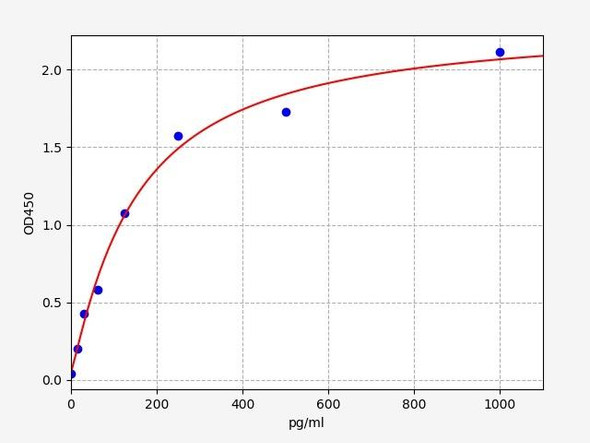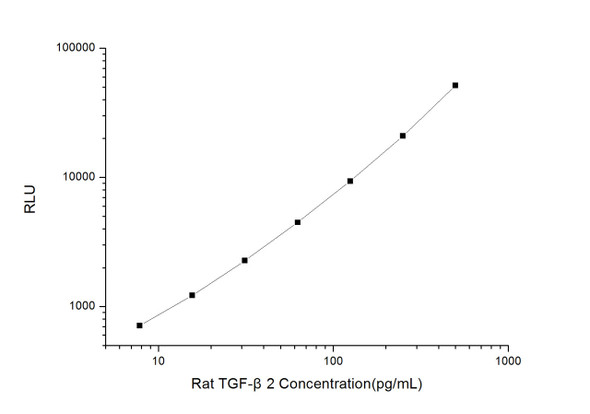Human Cell Biology ELISA Kits 5
Human TGF- beta2 (Transforming Growth Factor beta2) CLIA Kit (HUES00903)
- SKU:
- HUES00903
- Product Type:
- ELISA Kit
- ELISA Type:
- CLIA Kit
- Size:
- 96 Assays
- Sensitivity:
- 7.5pg/mL
- Range:
- 12.5-800pg/mL
- ELISA Type:
- Sandwich
- Reactivity:
- Human
- Sample Type:
- Serum, plasma and other biological fluids
- Research Area:
- Cell Biology
Description
| Assay type: | Sandwich |
| Format: | 96T |
| Assay time: | 4.5h |
| Reactivity: | Human |
| Detection method: | Chemiluminescence |
| Detection range: | 12.50-800 pg/mL |
| Sensitivity: | 7.50 pg/mL |
| Sample volume: | 100µL |
| Sample type: | Serum, plasma and other biological fluids |
| Repeatability: | CV < 15% |
| Specificity: | This kit recognizes Human TGF- beta2 in samples. No significant cross-reactivity or interference between Human TGF- beta2 and analogues was observed. |
This CLIA kit uses Sandwich-CLIA as the method. The micro CLIA plate provided in this kit has been pre-coated with an antibody specific to Human TGF- beta2. Standards or samples are added to the micro CLIA plate wells and combined with the specific antibody. Then a biotinylated detection antibody specific for Human TGF- beta2 and Avidin-Horseradish Peroxidase (HRP) conjugate are added to each micro plate well successively and incubated. Free components are washed away. The substrate solution is added to each well. Only those wells that contain Human TGF- beta2, biotinylated detection antibody and Avidin-HRP conjugate will appear fluorescence. The Relative light unit(RLU) value is measured spectrophotometrically by the Chemiluminescence immunoassay analyzer. The RLU value is positively associated with the concentration of Human TGF- beta2. You can calculate the concentration of Human TGF- beta2 in the samples by comparing the RLU value of the samples to the standard curve.
| UniProt Protein Function: | TGFB2: TGF-beta 2 has suppressive effects on interleukin-2 dependent T-cell growth. Homodimer; disulfide-linked. Heterodimers with TGFB1 and with TGFB3 have been found in bone. Interacts with the serine proteases, HTRA1 and HTRA3. Interacts with ASPN. Belongs to the TGF-beta family. 2 isoforms of the human protein are produced by alternative splicing. |
| UniProt Protein Details: | Protein type:Cell development/differentiation; Motility/polarity/chemotaxis; Secreted, signal peptide; Secreted Chromosomal Location of Human Ortholog: 1q41 Cellular Component: extracellular matrix; extracellular space; cell soma; axon; extracellular region; endosome Molecular Function:protein binding; protein homodimerization activity; growth factor activity; protein heterodimerization activity; beta-amyloid binding; punt binding; cytokine activity; transforming growth factor beta receptor binding; receptor signaling protein serine/threonine kinase activity; receptor binding Biological Process: heart morphogenesis; extracellular matrix organization and biogenesis; collagen fibril organization; catagen; heart development; dopamine biosynthetic process; SMAD protein nuclear translocation; protein amino acid phosphorylation; cell-cell signaling; hair follicle development; transforming growth factor beta receptor signaling pathway; somatic stem cell division; cell cycle arrest; cell growth; embryonic gut development; cartilage condensation; response to drug; platelet activation; neutrophil chemotaxis; negative regulation of immune response; neuron fate commitment; positive regulation of cell cycle; positive regulation of catagen; positive regulation of cell growth; positive regulation of phosphoinositide 3-kinase cascade; cardioblast differentiation; positive regulation of protein secretion; positive regulation of cell division; activation of protein kinase activity; neuron development; response to progesterone stimulus; positive regulation of heart contraction; cell death; axon guidance; positive regulation of immune response; wound healing; cell morphogenesis; cardiac muscle cell proliferation; positive regulation of stress-activated MAPK cascade; odontogenesis; negative regulation of cell proliferation; platelet degranulation; positive regulation of neuron apoptosis; salivary gland morphogenesis; positive regulation of cell proliferation; response to wounding; hemopoiesis; angiogenesis; positive regulation of integrin biosynthetic process; negative regulation of epithelial cell proliferation; uterine wall breakdown; intercellular junction assembly and maintenance; cell migration; regulation of transforming growth factor-beta2 production; hair follicle morphogenesis; positive regulation of cell adhesion mediated by integrin; glial cell migration; positive regulation of ossification; cell proliferation; embryonic development; eye development; generation of neurons; positive regulation of cardioblast differentiation; response to hypoxia; epithelial to mesenchymal transition; blood vessel remodeling; negative regulation of cell growth; blood coagulation Disease: Loeys-dietz Syndrome 4 |
| NCBI Summary: | This gene encodes a member of the transforming growth factor beta (TGFB) family of cytokines, which are multifunctional peptides that regulate proliferation, differentiation, adhesion, migration, and other functions in many cell types by transducing their signal through combinations of transmembrane type I and type II receptors (TGFBR1 and TGFBR2) and their downstream effectors, the SMAD proteins. Disruption of the TGFB/SMAD pathway has been implicated in a variety of human cancers. The encoded protein is secreted and has suppressive effects of interleukin-2 dependent T-cell growth. Translocation t(1;7)(q41;p21) between this gene and HDAC9 is associated with Peters' anomaly, a congenital defect of the anterior chamber of the eye. The knockout mice lacking this gene show perinatal mortality and a wide range of developmental, including cardiac, defects. Alternatively spliced transcript variants encoding different isoforms have been identified. [provided by RefSeq, Sep 2010] |
| UniProt Code: | P61812 |
| NCBI GenInfo Identifier: | 48429157 |
| NCBI Gene ID: | 7042 |
| NCBI Accession: | P61812. 1 |
| UniProt Secondary Accession: | P61812,P08112, Q15579, Q15581, Q4VAV9, B4DKC5, |
| UniProt Related Accession: | P61812 |
| Molecular Weight: | Calculated MW: 47kDa/50kDaObserved MW: 55kDa |
| NCBI Full Name: | Transforming growth factor beta-2 |
| NCBI Synonym Full Names: | transforming growth factor, beta 2 |
| NCBI Official Symbol: | TGFB2Ã? Ã? |
| NCBI Official Synonym Symbols: | LDS4; TGF-beta2Ã? Ã? |
| NCBI Protein Information: | transforming growth factor beta-2; G-TSF; cetermin; polyergin; BSC-1 cell growth inhibitor; prepro-transforming growth factor beta-2; glioblastoma-derived T-cell suppressor factor |
| UniProt Protein Name: | Transforming growth factor beta-2 |
| UniProt Synonym Protein Names: | BSC-1 cell growth inhibitor; Cetermin; Glioblastoma-derived T-cell suppressor factor; G-TSF; PolyerginLatency-associated peptide; LAP |
| Protein Family: | Transforming growth factor |
| UniProt Gene Name: | TGFB2Ã? Ã? |
| UniProt Entry Name: | TGFB2_HUMAN |
As the RLU values of the standard curve may vary according to the conditions of the actual assay performance (e. g. operator, pipetting technique, washing technique or temperature effects), the operator should establish a standard curve for each test. Typical standard curve and data is provided below for reference only.
| Concentration (pg/mL) | RLU | Average | Corrected |
| 800 | 50177 55107 | 52642 | 52616 |
| 400 | 20115 23353 | 21734 | 21708 |
| 200 | 10405 9011 | 9708 | 9682 |
| 100 | 4240 4864 | 4552 | 4526 |
| 50 | 2284 2092 | 2188 | 2162 |
| 25 | 1117 1003 | 1060 | 1034 |
| 12.50 | 480 538 | 509 | 483 |
| 0 | 25 27 | 26 | -- |
Precision
Intra-assay Precision (Precision within an assay): 3 samples with low, mid range and high level Human TGF- beta2 were tested 20 times on one plate, respectively.
Inter-assay Precision (Precision between assays): 3 samples with low, mid range and high level Human TGF- beta2 were tested on 3 different plates, 20 replicates in each plate.
| Intra-assay Precision | Inter-assay Precision | |||||
| Sample | 1 | 2 | 3 | 1 | 2 | 3 |
| n | 20 | 20 | 20 | 20 | 20 | 20 |
| Mean (pg/mL) | 42.53 | 83.87 | 394.01 | 38.54 | 92.24 | 398.33 |
| Standard deviation | 4.26 | 9.97 | 30.02 | 3.78 | 7.29 | 41.51 |
| C V (%) | 10.02 | 11.89 | 7.62 | 9.81 | 7.90 | 10.42 |
Recovery
The recovery of Human TGF- beta2 spiked at three different levels in samples throughout the range of the assay was evaluated in various matrices.
| Sample Type | Range (%) | Average Recovery (%) |
| Serum (n=5) | 98-111 | 105 |
| EDTA plasma (n=5) | 90-102 | 96 |
| Cell culture media (n=5) | 95-111 | 101 |
Linearity
Samples were spiked with high concentrations of Human TGF- beta2 and diluted with Reference Standard & Sample Diluent to produce samples with values within the range of the assay.
| Serum (n=5) | EDTA plasma (n=5) | Cell culture media (n=5) | ||
| 1:2 | Range (%) | 89-104 | 88-102 | 84-100 |
| Average (%) | 95 | 95 | 91 | |
| 1:4 | Range (%) | 95-108 | 94-109 | 92-107 |
| Average (%) | 102 | 102 | 97 | |
| 1:8 | Range (%) | 100-113 | 86-100 | 89-102 |
| Average (%) | 106 | 92 | 95 | |
| 1:16 | Range (%) | 92-104 | 89-101 | 84-98 |
| Average (%) | 97 | 95 | 91 |
An unopened kit can be stored at 4°C for 1 month. If the kit is not used within 1 month, store the items separately according to the following conditions once the kit is received.
| Item | Specifications | Storage |
| Micro CLIA Plate(Dismountable) | 8 wells ×12 strips | -20°C, 6 months |
| Reference Standard | 2 vials | |
| Concentrated Biotinylated Detection Ab (100×) | 1 vial, 120 µL | |
| Concentrated HRP Conjugate (100×) | 1 vial, 120 µL | -20°C(shading light), 6 months |
| Reference Standard & Sample Diluent | 1 vial, 20 mL | 4°C, 6 months |
| Biotinylated Detection Ab Diluent | 1 vial, 14 mL | |
| HRP Conjugate Diluent | 1 vial, 14 mL | |
| Concentrated Wash Buffer (25×) | 1 vial, 30 mL | |
| Substrate Reagent A | 1 vial, 5 mL | 4°C (shading light) |
| Substrate Reagent B | 1 vial, 5 mL | 4°C (shading light) |
| Plate Sealer | 5 pieces | |
| Product Description | 1 copy | |
| Certificate of Analysis | 1 copy |
- Set standard, test sample and control (zero) wells on the pre-coated plate and record theirpositions. It is recommended to measure each standard and sample in duplicate. Note: addall solutions to the bottom of the plate wells while avoiding contact with the well walls. Ensuresolutions do not foam when adding to the wells.
- Aliquot 100Ã ?Ã? µL of standard solutions into the standard wells.
- Add 100Ã ?Ã? µL of Sample / Standard dilution buffer into the control (zero) well.
- Add 100Ã ?Ã? µL of properly diluted sample (serum, plasma, tissue homogenates and otherbiological fluids. ) into test sample wells.
- Cover the plate with the sealer provided in the kit and incubate for 90 min at 37Ã ?Ã? °C.
- Aspirate the liquid from each well, do not wash. Immediately add 100Ã ?Ã? µL of BiotinylatedDetection Ab working solution to each well. Cover the plate with a plate seal and gently mix. Incubate for 1 hour at 37Ã ?Ã? °C.
- Aspirate or decant the solution from the plate and add 350Ã ?Ã? µL of wash buffer to each welland incubate for 1-2 minutes at room temperature. Aspirate the solution from each well andclap the plate on absorbent filter paper to dry. Repeat this process 3 times. Note: a microplatewasher can be used in this step and other wash steps.
- Add 100Ã ?Ã? µL of HRP Conjugate working solution to each well. Cover with a plate seal andincubate for 30 min at 37Ã ?Ã? °C.
- Aspirate or decant the solution from each well. Repeat the wash process for five times asconducted in step 7.
- Add 100Ã ?Ã? µL of Substrate mixture solution to each well. Cover with a new plate seal andincubate for no more than 5 min at 37Ã ?Ã? °C. Protect the plate from light.
- Determine the RLU value of each well immediately.






